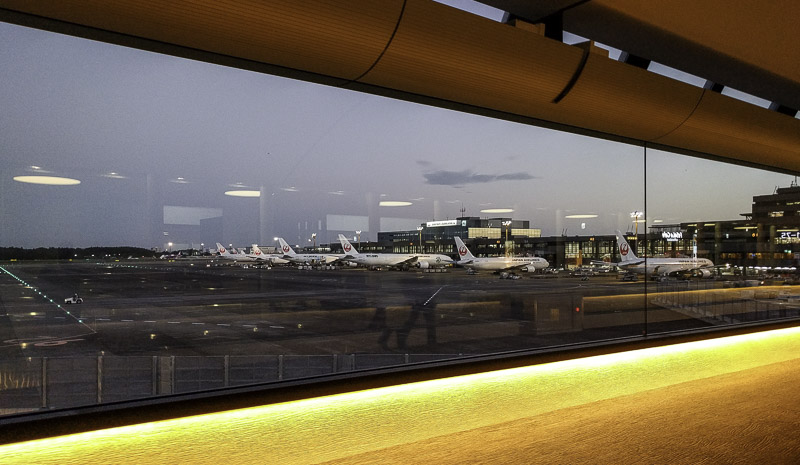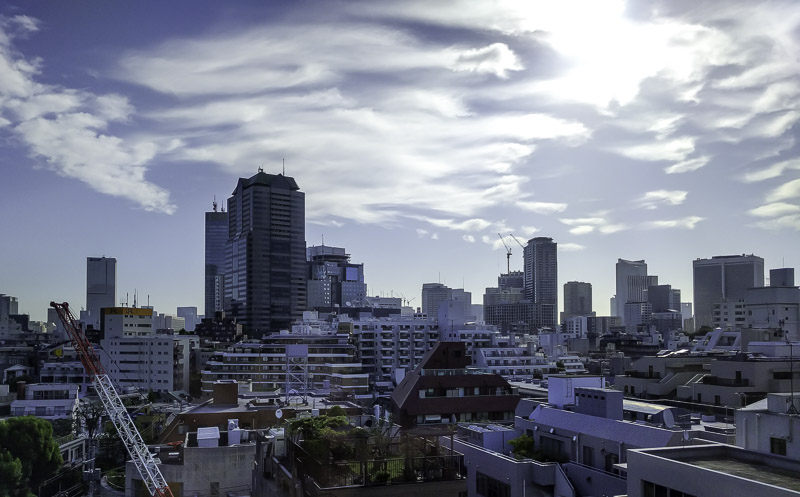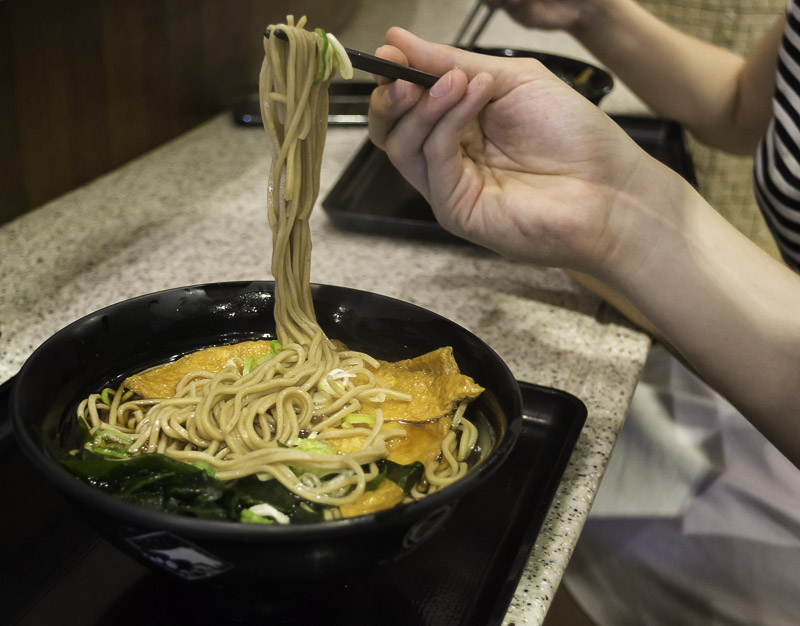Konnichiwa mina-san, boku no burogu ni youkoso. Or so I would begin writing were I writing in Japanese (also in kana, but let’s just assume the average reader doesn’t know kana and that I don’t want to scare anyone away). I’m in Japan! Alive and well, almost fully settled in to my apartment, I’ve begun my one year of fun and excitement.
A short list of what happened so far, in no particular order: I have
- been in a spaceship,
- moonwalked on a conveyor belt,
- got scanned for infectious diseases and had my biometric ID taken,
- left my luggage in the middle of the airport in hopes that a black cat would pick it up,
- got blown on by various sources of cold air and, conversely,
- got drenched in sweat in a sauna,
- bought a watermelon,
- figured out the watermelon wasn’t okay and bought a different one,
- walked a thousand miles and rode a thousand more,
- paid 1 yen to wait an hour and a half, twice,
- wet various body parts with divine water,
- put many unknown things into my mouth, then swallowed them,
- watched my clothes swirl in a pool of cold water for a while,
- spoke somewhat reasonable Japanese in everyday situations or
- used copious amount of hand gestures where I couldn’t explain something well enough,
- got yelled at at the shop (actually, all of them),
- been suspected of being in the Yakuza,
- thought I went deaf for a second,
- read more signs than I probably have my entire life,
- and, of course met many many many very nice Japanese people whose culture I love even more after coming here.
Want to know more? Read on.
I’d like to start the main body of this blog post by stressing, quite intensively, how exceptionally nice every single Japanese I met so far was. As I’m sitting on my futon, in a room cooled by the semi-audible whirring of the ubiquitous air-conditioning unit, drinking self-made iced-tea, listening to World Order, recalling the five or so days I’ve been here, it almost brings me to tears how much fun and pleasant experiences I’ve had. You can’t imagine how polite everyone is. Not a robot, everyone just cares about their fellow humans and works to preserve unity and goodness in every aspect of life. This will become more clear with the following paragraphs, but the only thing you can do to really get it is spend at least a week here. Not as a tourist, tourist attractions leave you with a warped perspective due to the incessant pestering of just about every visual pixel in your field of vision. Just take a train during the early or late rush hour (to avoid getting sardined) and observe everyone. Then go on a walk through a residential or non-tourist commercial area and into a shop. You’ll see what I mean. It’s completely unbelievable. Completely different from any other culture I am aware of, the Japanese have one that is very special.
With that over with, let’s start explaining some of the ambiguities in the bullet points above. I’d best write this chronologically, or at least as close to it as possible, lest I forget something and you get confused and feel left out. I flew with Emirates through Dubai, and what an adventure that was! Having never been in a “normal” airplane, only budget ones, I was blown away by what Emirates offer. Don’t take this as a promo, and keep in mind this is the only real arline I flew with, but my experience was exceptional. First off, the spaceship: the seat you get kind of looks like the inside of a spaceship (check out the album to see it), with all the controls and the touchscreens and equipment. The food is also very very good and arrives at just the right times. You can also ask for drinks in the middle of the flight, but that is normal from what I know. When we had to transfer at the Dubai international airport, what really struck me as strange was the sheer size of it. First off, they have a train to connect different terminals, and every room is about ten times as big as it should be. It was also very very hot in Dubai, but the only time we felt that heat was in the couple of meters when we left our bus (a 10 minute bus ride from the gate to the plane) to go onto the plane itself. They haven’t figured out how to air-condition the whole country. Yet.

It was about time for a picture, right? There is also a whole album linked at the top and at the bottom of the post with a lot more. This was from when we arrived at Narita, Japan’s second busiest airport. It’s quite a bit smaller than Dubai’s, but, then again, there aren’t many larger ones. They have handy conveyor belts you walk on to go faster, they are very fun after a long flight: you can walk backwards, moonwalk, stand still but still move and so on. Endless fun! Arriving at the first security checkpoint, we got a taste of Japan’s strict immigration policy. Just before the immigration offices, they have a checkpoint where a thermal camera checks your body temperature to prevent any apparent diseases from getting through. They have a laboratory and everything. Next up was immigration, where we were directed to a separate line as we don’t have a tourist visa. Since about 2007, it’s mandatory to give your fingerprints and picture to the immigration officer, who then provided us with a residence card. I believe it’s appropriate to point out that they were very kind through the whole process, from the first interaction onwards.
After that, getting our luggage and going through customs. The airport personnel already got our luggage off the conveyor belts and grouped matching pieces together and there was a man standing there with an Emirates sign until the last person came to pick up their luggage. That wasn’t an Emirates employee. That was a Narita employee. Going through customs was painless, as they already gave us slips to fill out on the plane, where we had to confirm that we weren’t bringing any marijuanas and that we weren’t travelling with obscene amounts of cash money.
Next up was somehow getting rid of our luggage, as travelling with 30 kg of goods would be quite something. In Japan, there is a service where you can send your luggage from the airport to your home (or vice versa) for a very reasonable price. The only strange thing was that we left (as instructed) our luggage at the middle of the airport, close to the counters. Weird, but hey, they’re supposed to be good at this right? In the end, the luggage arrived safely and undamaged to the apartment. Oh, the black cat thing is a reference to Japan’s biggest delivery company, Kuroneko Yamato, which kind of means “japanese black cat”.
After that we went to a hotel for our first night and experienced the Japanese heat for the first time. It’s not that it’s scorching hot or anything, it’s the humidity that gets you. And the fact that, even now, it doesn’t go below 26 degrees at night. The hotel was fun and we watched our first Japanese television shows before going to an orientation meeting in the morning, with smart casual clothes unbefitting the weather. At another reception the following day, we were treated to great food and met representatives of our country’s embassies, our teachers and representatives from most companies.

When leaving the airport by train, we got our first Japanese train experience. Punctual as always, we were surprised by the comfortable seats and the nice air-conditioning on the train. That was very nice, as the outside air is really humid and, already sweating from the long flights, it really feels bad. Fortunately, we cooled off. Speaking of trains, this is an explanation for the watermelons above. To use the Japanese train system, you can use paper tickets, or get an IC card to put money on for convenience and small savings. Any way, one of those cards is called Suica, which kind of means watermelon in Japanese. The reason I got another kind of watermelon (called Pasmo), and this is a tip for future Vulcanusonianites, is because my commuting route doesn’t include any JR (Japanese Rail) lines, and a Suica requires you to have at least one JR route in your commute. Otherwise you need to buy a Pasmo. Suica has a funnier name, but, in the end, they’re both just things you use to go through the ticket gates at great speed in a crowd.
When people think of Japanese food, they think sushi. But there’s so much more to Japanese cuisine than that. I’m not claiming to have tried everything; on the contrary, I only tried a couple of kinds of ramen, some onigiri (rice balls) and chicken karaage (think KFC, but Japanese and a lot healthier). The first difference in those ramen shops is that you go to a vending machine to order, then get your food at the cashier/cook/other tasks person, as opposed to ordering from a menu they bring you. In general, I noticed you are supposed to order first, then sit down. But maybe that is just some selection bias.

A thing we had to do was get a Japanese phone number and a SIM card so we have some internets. That’s what the hour and a half is a reference to: due to there being a bit of a crowd, we had to wait twice for an hour and a half so they did something, but, in the end, paid only 1 yen for the initial contract. We had time for sightseeing: we went to the Yayoi park where the Meiji dynasty shrine is. See the pictures, the place is very pleasant, but kind of a popular tourist destination. Still worth it.
Don’t worry about any suspected aggression against me from the couple of bullet points above. The person who “suspected” me of being in an organized crime syndicate was just an employee of a Japanese bank where I opened my bank account. There is actually a whole page of terms which describes the kinds of criminal organizations you can’t be a member of to open an account, and she was just informing us that our accounts may be suspended if we ever got involved with such activities. And the yelling in shops? It’s normal. Everyone greets you with a loud welcome when you step inside, and then thanks you for your visit when leaving. You’re not supposed to acknowledge them. They just yell at you. How strange.
Some other, miscellaneous things to mention. The trains are very quiet. Not the machines, the people. In the morning rush hour, where we were sardining our way to Shibuya, no one was making a sound. With a completely packed train car. No music blaring from three different phones and a dozen yelling conversations all around you. Just the sound of the train tracks and the conductor’s announcements. Speaking of announcements and sounds, you really can’t get lost in the train system if you know where to go. I know that sounds obvious, but there are signs everywhere, even in English, with tracks colour-coded for simplicity. Really nice. And, if you somehow don’t know where to go, there are helpful station attendants or policemen that explain everything. I also saw a policeman carrying a woman’s stroller up a considerable number of stairs, so she could hold her baby. Unheard of anywhere else. Policemen here are great. The last thing I wanted to mention, completely unrelated, is that in Japan, washing machines run on cold water. Weird, huh?
Well, I hope this didn’t drag on for too long. I don’t really have a talent for (nor do I think I am any good at) writing blog posts, so I hope writing a kind of train of thought was okay. There will be posts on specific topics coming up, so stay tuned! At least that’s the plan, I need to study too. You’re kindly invited to browse through the photo album linked at the bottom (and top) of this post to see some highlights in much better quality. These albums aren’t photo dumps, I actually go through the myriad of photos I make and process the best ones. Not that I’m a photographer or anything. Mata atode!
See the full album linked to this post here (click)!